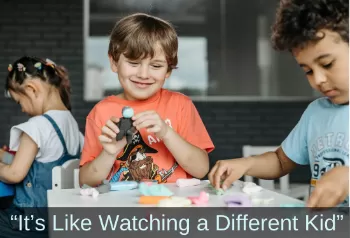Primitive Reflex Integration Case Studies
Highly Anxious 7-Year-Old Separates from Mother, Gains Balance, and Develops Nice Handwriting
Dramatic improvements with separation anxiety and more!
Before this 7-year-old's mother introduced neurodevelopmental movements into their home, he would not leave her side or sleep in his own bed. See how techniques from the Brain and Sensory Foundation First Level course helped this little boy become more confident and independent.
Submitted by Anonymous parent

| Before | After |
|---|---|
| Would not leave mother's side | Able to play separately in a different room |
| Would not sleep alone | Allows mother to leave the room at night and sleeps alone |
| Complained that the bus, cafeteria, and gym were too loud | Not as sensitive to noise |
| Had a hard time standing on one leg | Improved balance; steadier and not falling over constantly |
| Fatigued when writing | Hands do not get as tired anymore when writing |
| Poor penmanship | Teacher says he has nice handwriting! |
Due to the pandemic, my husband and I work from home and my 7-year-old child is doing full-time remote learning. We are together practically 24-hours a day. In the beginning, my child would not leave my side. Everywhere I went, he went. At night, he would not sleep alone. I knew that I could not continue like that because I needed my space. Therefore, I chose to start doing the 5-step balance process with the goal of integrating his FPR [Fear Paralysis Reflex].
I kid you not, within about 2-3 sessions, he was letting me leave the room at night and sleeping alone. I had to leave the door open, leave the hallway light on, and talk to him from my bedroom, but still that was a huge difference. I was shocked. I continued to do the 5-step balance with him and I would say within a month or two, he progressed to being able to play separately in a different room.
In the beginning of the course, I felt that the 5-step balance process was just a nice extra and only half-heartedly tried it. But after the success I had using it, I became a firm believer. We now do the 5-step balance every morning before school where we do self-affirmations and acting out of whatever is difficult for him.
Before the pandemic, my son was having behavioral as well as sensory processing issues at school. He complained the bus, cafeteria and gym were too loud. He was tactile defensive when someone touched him. This was an issue whenever kids lined up and accidentally bumped into one another. When he gets anxious, he plays with his tags and sucks his thumb.
On top of that, he could not sit upright for 15 seconds (even when bribed). This came as a shock because he is very athletic. He traversed the monkey bars and learned to ride a bike at 4, completed a triathlon at 6 and got 2nd place, and could hit a baseball without a T at 2-3 years old. We had noticed that he had a hard time sitting still at the kitchen table, but just thought he was fidgety. I did wonder though why after 3 years of martial arts, he still had such a hard time with a standing 1-leg balance.
After going through the course, I tested all 9 reflexes [from the Brain and Sensory Foundations course] and found out he tested positive in every single one. I decided to do rhythmic movements and implement Moro [Reflex] and TLR [Tonic Labyrinthine Reflex] first. After about 6 weeks. I noticed that during TLR testing, he was not swaying as much. After about another 6-8 weeks, the most noticeable change was his standing 1-leg balance in his kung fu class. He is steadier and not falling over constantly. It is like watching a different kid!
I also think that he is not as sensitive to noise. There have been moments where I expect him to be reactive and he is not. But this is an area where he has not been truly challenged due to the pandemic and being at home with remote learning.
After that, I started working on integrating his ATNR [Asymmetrical Tonic Neck Reflex] and STNR [Symmetrical Tonic Neck Reflex] because of his complaints of getting tired when writing, his poor penmanship, visual processing issues, squirming, and fidgeting, and pulling back when a ball is thrown at him.
After about 6-8 weeks, he reported that his hands do not get as tired anymore when writing. Best of all, his teacher says he has nice handwriting! And when he does duck or penguin walking, his arms are not as tied to what his legs are doing. In the beginning, he needed to hold his hands together to keep his arms up during ATNR testing. Now he can do it without holding his hands.
We made substantial progress and hope to see more gains with time, and as we add in more reflexes to work on.
[Edited for length and clarity; emphasis added]
*Disclaimer: The activities in the Brain and Sensory Foundations curriculum make use of the natural processes of neuroplasticity and development that are innately wired in the design of human beings to promote maturity and function. These activities appear to calm, organize, and mature the neuro-sensory-motor systems just as we see in the healthy development of human infants. Individual results may vary, and we do not claim to offer a diagnosis or cure for any specific condition or disorder. The Brain and Sensory Foundations activities appear to improve overall functioning resulting in measurable improvements for a range of conditions as demonstrated in over 1800 case studies from participants.

